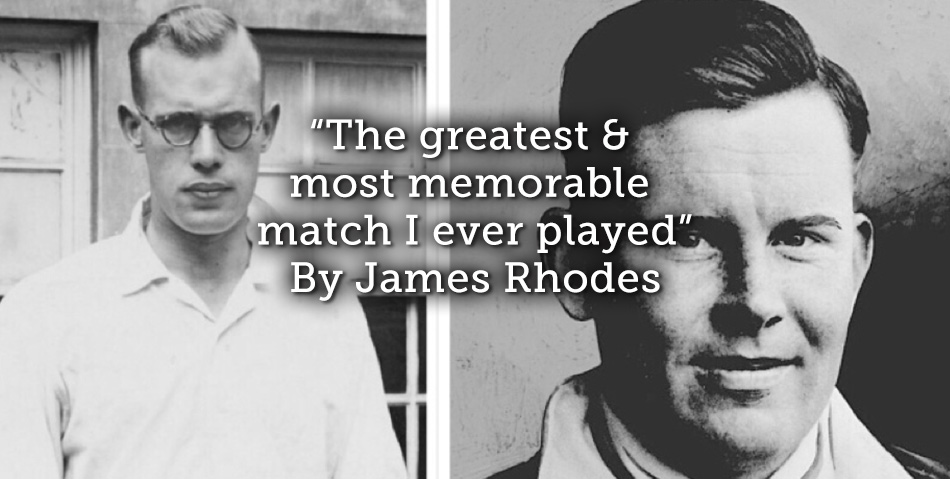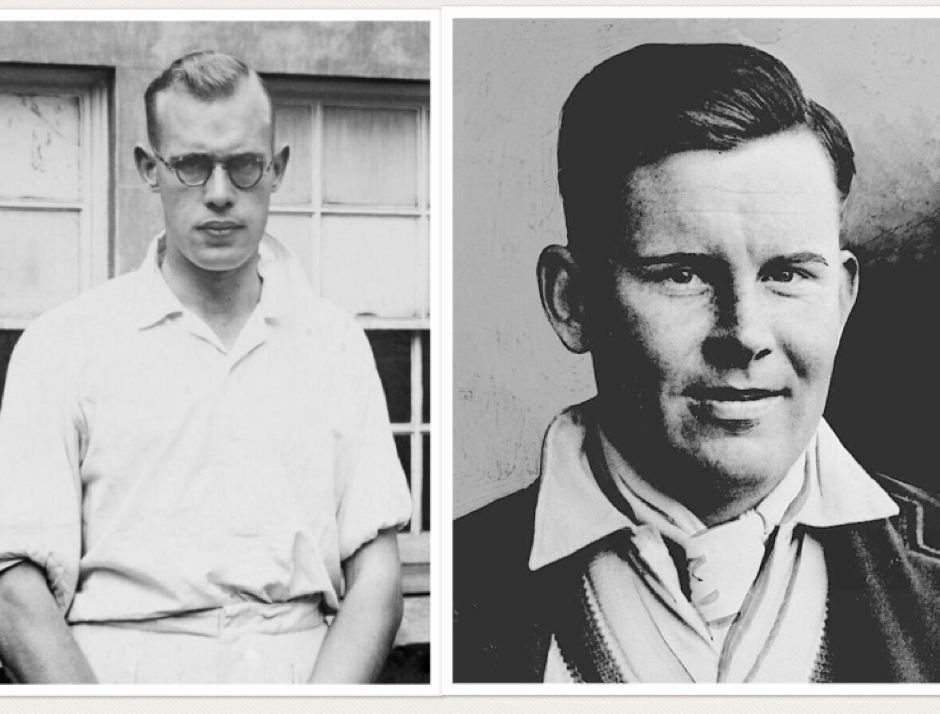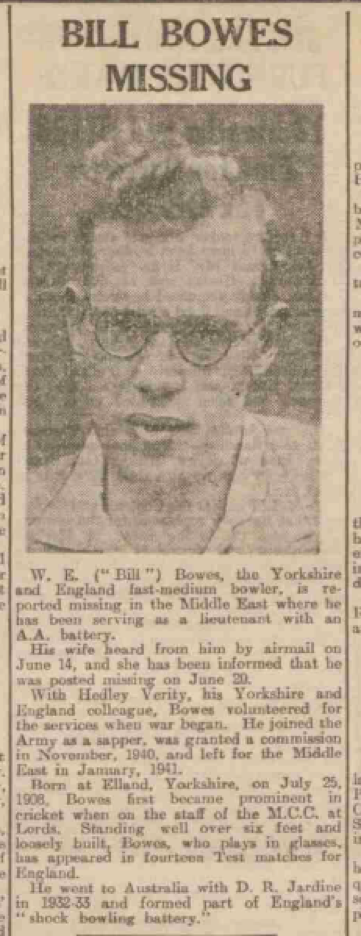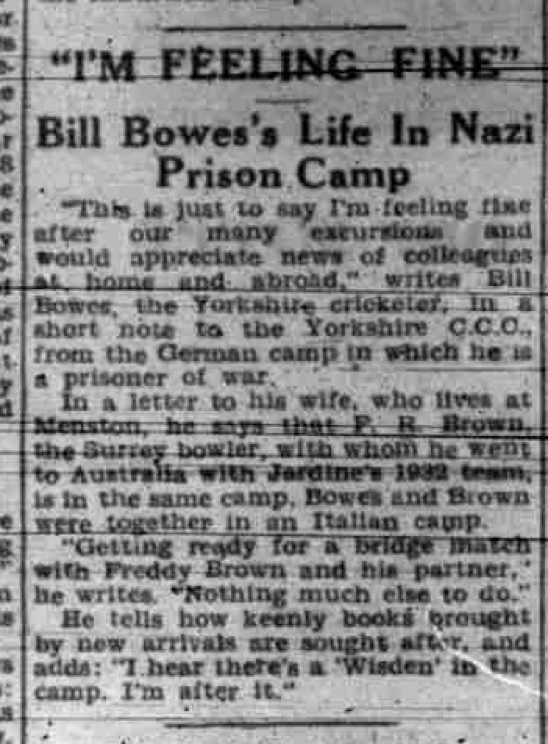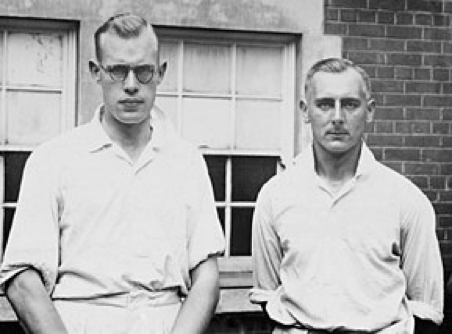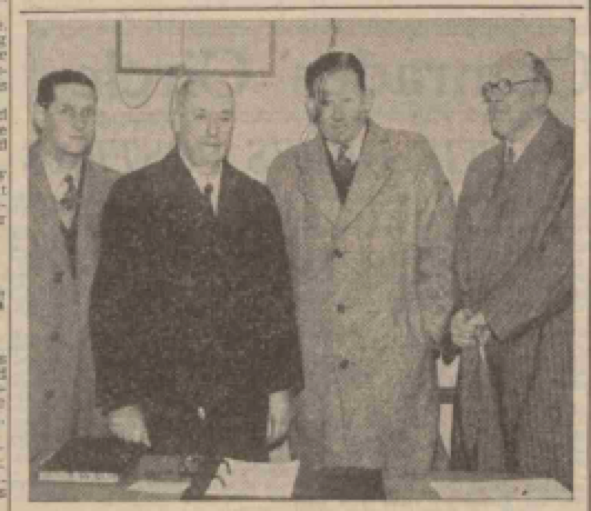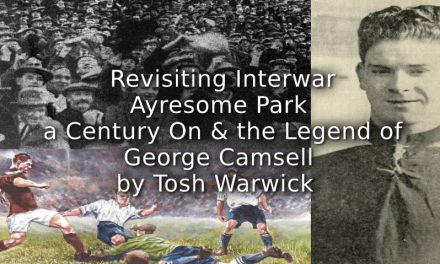During their captivity in a notorious Italian POW camp in World War Two, England cricketers Bill Bowes and Freddie Brown staged one of the most remarkable cricket matches in history. This is the story of that game.
- Bill Bowes (left) and Freddie Brown
On 20 June 1942, England cricketers, Bill Bowes (Yorkshire) and Freddie Brown (Surrey and future England captain), were taken prisoner by a German-Italian force after the Allied surrender at Tobruk, Libya, with more than 30,000 others. They were transported across the Mediterranean and eventually to Chieti prisoner of war camp.
-
“Bill Bowes Missing”
(Dundee Evening Telegraph of Monday 13 July 1942)
Life in the camp was terribly harsh: it was overcrowded, with poor sanitation and very little food. The fascist guards exacted brutal punishment on anyone who tried to escape. In spite of these privations, morale amongst the prisoners remained high and this was due in no small part to Bowes’s role as the camp’s Sports Officer, organising games of all descriptions using improvised materials and equipment.
The ingenuity, resourcefulness and spirit of the prisoners were all demonstrated in a remarkable game of cricket which was played in the camp on 3 July 1943 and which Bowes, a veteran of the Bodyline Series, described as the “greatest and most memorable match in which I ever took part.”
-
Exert from a letter from Bill to is wife
(Yorkshire Evening Post – Tuesday 22nd February 1944)
By this time, the Red Cross had delivered a supply of sports equipment. Although this included cricket bats, there was no other cricket equipment. In spite of this, Bowes organised a match that was intended to evoke, as far as possible, a game on an English village green. Using material that had been begged, borrowed, stolen or bribed for, the men of the camp made everything necessary for the occasion as detailed below.
Outfield – the game was staged on a rectangular area of ground, surrounded by the cook-house and various huts and bisected by a tarmac road, which they painted green with distemper.
Strip – the pitch was ostentatiously rolled using a makeshift roller shortly before the scheduled start of play. Creases were marked out with white paint.
Stumps – sawn down broom handles.
Ball – a set of six balls was handmade by Major Denis Lamplugh from leather taken from the uppers of prisoners’ boots. Bowes said that they “could have been sold in any cricket shop”. Five of the six were lost during the day’s play.
Pads – these were made from the stiff cardboard of the Red Cross parcels.
Wicketkeeper’s gloves – a pair of stolen Italian leather motoring gloves stuffed with extra padding.
Cricket whites – made from bed linen by the camp’s theatrical department.
Umpires’ coats – two white medical coats stolen from the hospital block.
Pavilion – one of the prison huts on top which was built a large wooden clock. A prisoner spent the game inside the clock, manually moving its hands in real time. In front was a members’ enclosure, complete with wooden railings and deck chairs.
Sightscreen – made from stolen bed linen.
Bandstand – made of tables and blankets. During the first half of the game, ‘Pitso’ and his orchestra played instruments borrowed from the guards. The second half of the game was accompanied by Tommy Sampson and his band. Sampson played a trumpet with only two valves, the third having been removed to store an escape map. He became a famous bandleader after the war.
Scoreboard – a wooden scoreboard was erected next to the pavilion and it was large enough to be seen throughout the whole camp.
The game began at 2pm and none of the surviving accounts record the scores. However, we know that Brown bowled excellently, and an Indian officer named Gardener took a hat-trick. Beaumont (a Yorkshire second-team player) “played a fine back-to-the-wall innings and Bull (of Essex) batted most academically”. Brown scored 30 after failing to walk when he was caught second ball but given not out.
At one point, a suspicious Italian guard walked into the middle of the pitch and disrupted play. Brown urged Bowes to bowl straight at him but Bowes refused saying “I might kill the bugger!”.
Although we do not know the result, Bowes described the finish as follows:
“And what a finish it was! To describe it as close would be an understatement. Men never raced against time with such dogged determination and exciting effort. All the while time – and the players – were being deftly egged on by the careful manipulation of the hands of the giant pavilion clock worked by a man concealed inside.” (from Express Deliveries by Bill Bowes)
Later the same summer, Bowes received the shattering news of the death of his Yorkshire and England team mate and best friend, Hedley Verity, who had died of wounds sustained during a raid in Sicily.
- Bowes pictured with Verity, 1932
The Italian surrender of September 1943 did not bring an end to the men’s ordeal. No sooner had the Italian guards fled than the Germans arrived and transported the prisoners to Germany where conditions were even worse. By the time that Bowes returned home in the Spring of 1945, he had lost four and half stones in weight. Although he resumed his playing career, it was ended by injury in 1947. He went on to enjoy success as a cricket writer.
Brown captained the England side on its tour of Australia and New Zealand of 1950-51.
-
Freddie (2nd from right) with officials from Daventry British Legion where he gave a talk on cricket in 1950
(Northampton Mercury – Friday 13 January 1950)
Article © James Rhodes
First published by the author on – https://rhodestothepast.com/

